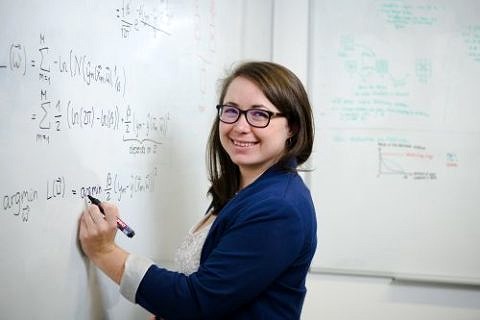Using AI to solve crime

FAU doctoral candidate Franziska Schirrmacher nominated as AI newcomer
Franziska Schirrmacher, doctoral candidate at FAU’s Chair of IT Security Infrastructures, develops methods of finding digital traces in image or video files that can subsequently be used to solve crime. In recognition of her research, Schirrmacher has been shortlisted for the AI newcomer of the year award by the German Informatics Society. In an interview, we discussed her research and what she finds so fascinating about artificial intelligence (AI). You can vote for the AI Newcomer 2021 until 7 March 2021.
You’re researching into multimedia forensics for your doctoral thesis. What does it involve exactly?
In simple terms, multimedia forensics involves finding digital traces in image or video data that can help to solve crime. These traces are used to reconstruct past events. One example from my current research is identifying car number plates in poor quality images. This means we try to reconstruct an illegible car number plate, for example from the vehicle used by a criminal.
What do you find so fascinating about artificial intelligence?
What fascinates me the most about artificial intelligence are the new opportunities it provides. I was fascinated when I observed how much information in the image data is hidden to the human eye, above all in number plate recognition. Artificial intelligence is pushing the limits of what we think is possible.
What makes you an AI newcomer?
At the end of my degree and at the beginning of my doctoral degree, I investigated conventional image processing methods. After participating in a summer school, I discovered my passion for AI and the opportunities it offers to me. My current work now focuses on combining conventional image processing methods with AI methods. I have found that combining these two fields can provide good and reliable results. At the same time, my methods not only serve academic research, but could also be effective in products due to their reliability.
How did you get into computer science?
I didn’t learn anything about computer science at school, which is why I chose to study medical engineering. During the first semester of my Bachelor’s degree, I developed an enthusiasm for computer science and decided to study image processing as part of my degree programme.
Why is FAU the ideal location for AI research?
My position at two different Chairs of Computer Science at FAU – initially at the Pattern Recognition Lab and now at the Chair of IT Security Infrastructures – means I have been able to benefit from the broad range of experience of my colleagues and supervisors in the field of AI. Exchanging ideas and information with other disciplines in computer science enables us to create new and innovative ideas that push research into AI forward. In addition to university research, FAU has strong ties to industry. Research topics arise from the needs of industry and findings are transferred to applied solutions. Both FAU and its partners in industry benefit from the close proximity of research to applications and products.
Which major scientific advances would you like to see in your field in the future?
A great deal of progress has been made in the field of artificial intelligence during the last few years. For several applications, above all in multimedia forensics, understanding how neural networks function in AI is important in addition to further innovation. Understanding how artificial intelligence reaches its results will increase trust in the technology. I see a great deal of potential in this area for further research. In my area of research, this means allowing AI forensic methods in court. It is more likely that our results will be trusted if we can explain the methods behind AI and by introducing quality assurance methods.
Your vote counts! Voting for AI Newcomer of the Year 2021
The German Informatics Society is turning the spotlight on young committed AI researchers from all disciplines and recognising the achievements of 10 excellent newcomers in AI. 6 young researchers are nominated in each of the 5 disciplines and one vote can be cast per discipline. Votes can be cast until 7 March. More information is available on the German Informatics Society website.
You can vote for Franziska Schirrmacher, who is nominated in the Computer Science discipline, here at kicamp.org .
In addition to Schirrmacher, FAU researcher Dr. Andreas Kist from the Division of Phoniatrics and Paediatric Audiology at the Department of Otorhinolaryngology at Universitätsklinikum Erlangen has been nominated in the Technical and Engineering Sciences category.
Further information
Franziska Schirrmacher
franziska.schirrmacher@fau.de